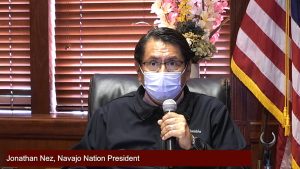- Slug: BC-CNS Navajo COVID, 560 words.
- 1 photo and caption below.
By Bree Florence
Cronkite News
PHOENIX – After weeks of grim news as the pandemic tore through the Navajo Nation, the curve of positive COVID-19 cases has begun to flatten, President Jonathan Nez said Thursday.
The rate of hospitalizations peaked April 25, Nez reported during a town hall on Facebook Live, nearly a month ahead of the mid-May date projected to be the peak by the Navajo Area Indian Health Service projection rate.
“We did what it took, working together, all of us,” Nez said. “You stayed home, and that’s what brought these numbers – and the curve flattened.”
For weeks, the Navajo Nation has issued curfews and weekend-long lockdowns in an attempt to slow the spread of the novel coronavirus that causes COVID-19. An eighth curfew has been called for this weekend.
As of Thursday, there were 4,944 confirmed cases on the reservation, according to the Navajo Department of Health. But while the rates are slowing, Nez expressed concern that the tribe could witness a spike in positive cases as cities bordering the reservation begin to reopen businesses. He was especially concerned after witnessing the crowds across the state over Memorial Day weekend.
“It is most important, very important that we stay home,” Nez said. “But now is not the time to go to the big cities. Now is not the time to be vacationing. What affects us here in the Navajo affects everyone across the nation.”
Nez pledged to continue Navajo Nation’s high testing rate. Tribal officials administered more than 32,000 tests – more than 15% of Navajos living on the reservation, a per capita rate that exceeds some states and countries, Nez said.
Additionally, Nez said, the tribe is receiving up to 30,000 more tests and setting up new testing centers, including one held Friday at Tuba City High School.
Also Thursday, the Hopi Tribe and Tohono O’odham Nation received about $1.2 million in pandemic relief from the U.S. Department of Health and Human Services.
“The COVID-19 pandemic has hit many Tribal communities, particularly in rural areas, very hard,” HRSA Administrator Tom Engels said in a statement. “By directing new resources to these areas, we are hoping to make a difference that will result in fewer new infections of this pernicious virus.”
Despite the increased monetary aid, Nez criticized the federal government for unequal distribution of funds to tribes and how late the funds arrived.
“I’m sorry to say to the federal government, that these numbers are because of the Navajo Nation and friends of the Navajo working together – the Hollywood stars, those individuals who donated,” Nez said. “That’s the resilience of our people and our friends who help.”
He called on Navajos to “shift their focus to petitioning Congress” and demand “that (Native American) nations need to be assisted to become more equal to the rest of the United States population.”
As the nation looks at another weekend curfew and shelter-in-place orders, Navajo chapters will continue to pass out donations of food, water and other supplies locally.
Nez commended first responders, police officers, volunteers and everyone on the front lines for their hard work.
“You helped flatten this curve by working together,” he said. “It makes me proud to be right on the front lines with you. You inspire me. You inspire me to fight harder for the Navajo people. … You are all warriors. Thank you.”
For more stories from Cronkite News, visit cronkitenews.azpbs.org. ^_=
